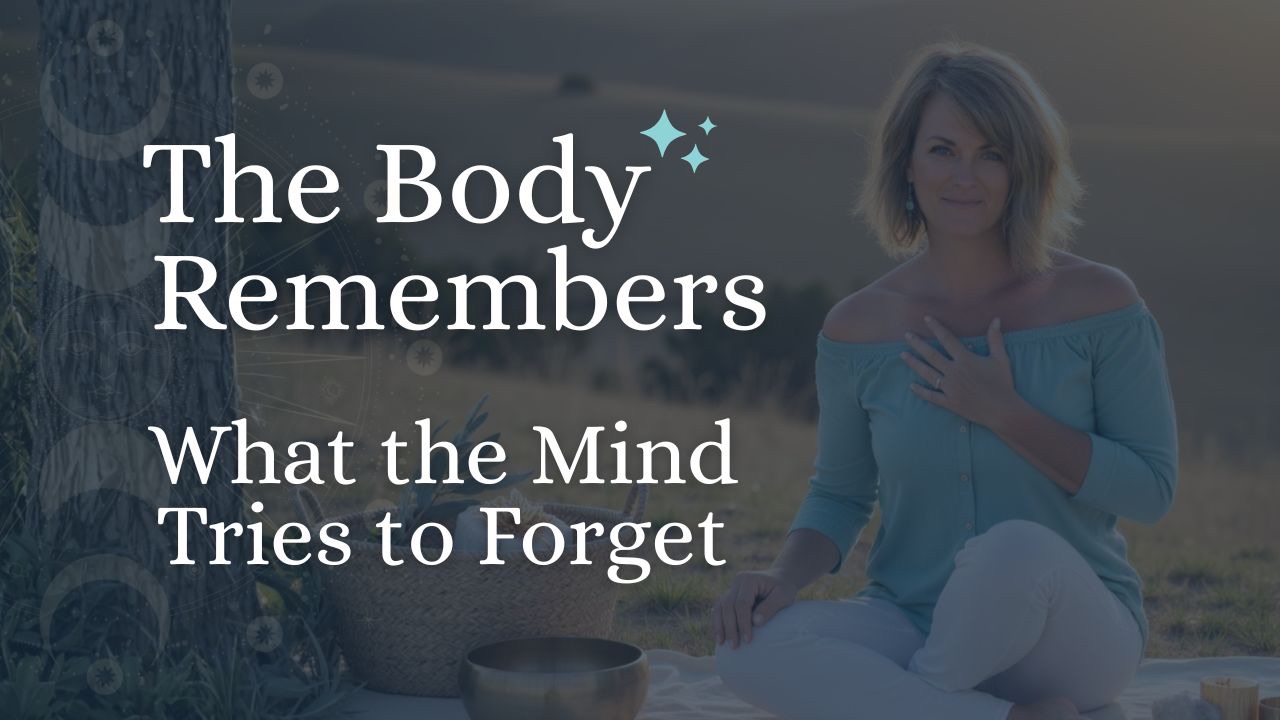How Your Body Holds Trauma: Understanding the Connection Between Mind and Body

Ever felt like your body is holding onto your past like it’s the world’s worst hoarder? It might sound wild, but guess what? Your body isn’t just a fancy suit of skin and bones—it's a living, breathing repository of everything you’ve ever been through. Yep, all those unresolved emotions and traumas?
They’re getting filed away in your cells, waiting for you to deal with them.
What prompted my writing today is a kids birthday party.
Yesterday I took my 3 year old to a birthday party. I met his Dad for the first time, and his beautiful Mum said to her husband "Hey she does Kinesiology"
He pulled me to the side like I was in some secret service and said "I love kinesiology, after years of debilitating pain in my back and seeing every specialist under the sun I decided to try Kinesiology. I thought what's this woo, woo stuff, but the kinesiologist did the muscle checking stuff and worked out my back pain was stored emotions from seeing my mother being thrown by my father into a cupboard, in which she hurt her back. I was only 4 and never thought about it since, but some how my body remembered".
"Yep" I said. "Our bodies remember everything"
You might think of your body as a secret storage unit. The brilliant minds of Bessel van der Kolk in The Body Keeps the Score and Dr. Peter Levine have mapped out how these emotional landmines get buried deep in your physical self, storing them away until you're able to prcess them.
These aren’t just abstract ideas; they’re real, physical sensations and symptoms that can surface when you least expect them. Ready to crack open that storage unit and start organising? Let’s dive into how you can tackle these hidden burdens and reclaim your well-being.
What is Trauma?
Trauma refers to deeply distressing or disturbing experiences that can overwhelm our ability to cope. These can range from significant events, like accidents or abuse, to smaller, chronic stressors that accumulate over time. The impact of trauma isn’t just emotional or psychological; it affects the body too.
So, let’s cut to the chase: trauma isn’t just about those dramatic, headline-worthy events that knock us off our feet. Sure, big stuff like accidents or abuse can leave their mark, but here’s the kicker—trauma is more about what’s simmering beneath the surface. It’s not just the events themselves; it’s the mess they leave behind in your body.
Think of trauma like this: it's not just the earthquake that shook your world; it’s the aftershocks that rattle your insides long after the quake.
Whether it's a major life event or a series of nagging stressors, trauma turns into a chronic state of chaos that your body carries around like a heavy, invisible backpack.
The impact goes way beyond the emotional rollercoaster and messes with your physical self, leaving you with more than just mental scars. It’s your body’s way of saying, “Hey, I’m still processing this!”
The Body-Mind Connection
Our bodies are intricately linked to our minds. When we experience trauma, the emotional distress often gets stored in our bodies. This happens because our stress response system, which includes the autonomic nervous system, gets activated. Over time, if the trauma is not processed or resolved, it can lead to physical symptoms and health issues.
Think of it this way:
When trauma hits, your stress response system, the one that’s supposed to help you survive—gets thrown into overdrive. This means your body starts hoarding that emotional baggage like it's the last piece of luggage on a deserted island.
Here’s the lowdown: when you don’t deal with trauma, it doesn’t just vanish into thin air.
Nope, it gets stashed away in your body’s hidden corners, thanks to your autonomic nervous system.
This means that all those unresolved feelings and stressors turn into physical symptoms, like chronic pain or mysterious health issues (like my story above).
It’s like your body’s holding onto a secret file of distress, and unless you address it, those symptoms will keep popping up, reminding you that the emotional stuff is still very much in play.
How Trauma Manifests in the Body
-
Physical Symptoms: Trauma can lead to chronic pain, muscle tension, headaches, and digestive issues. For example, someone who experienced a traumatic event might have persistent back pain or digestive problems, even if they haven't been able to pinpoint a physical cause.
-
Posture and Movement Patterns: Trauma can affect how we move and hold our bodies. You might notice changes in your posture or habitual tension in certain areas. This is the body’s way of trying to protect itself or deal with unresolved emotions.
-
Emotional Responses: Unresolved trauma can lead to heightened emotional responses. You might find yourself easily triggered, experiencing anxiety, or having mood swings that seem disproportionate to the current situation.
The Work of Bessel van der Kolk and Dr. Peter Levine
In The Body Keeps the Score, Bessel van der Kolk explores how trauma affects the brain and body, emphasising the importance of addressing both. He explains that traditional talk therapies may not be enough because they don’t always reach the body where trauma is stored. Instead, integrating body-centered approaches can be crucial for healing.
Dr. Peter Levine, in his work on Somatic Experiencing, focuses on how trauma is stored in the body and how it can be released through physical sensations and movements. His approach helps individuals reconnect with their bodies, understand where they hold tension, and work through trauma at a somatic level.
Healing and Moving Forward - Modalities I Offer to Help Heal Stored Trauma
-
Mindfulness and Somatic Practices:
Techniques such as mindfulness, yoga, and somatic experiencing can help you become more aware of where and how you hold tension.
These practices encourage you to listen to your body, moving towards what it's trying to resolve within and help you release stored trauma. Take the first step and check out our online offerings HERE
-
Kinesiology:
I studied to become a Kinesiologist nearly a decade ago and use it in my practice often. A kinesiologist is a practitioner who is trained in helping determine what emotions the body is experiencing. Kinesiology, as a modality, is grounded in the study of anatomy and physiology.
It combines muscle monitoring, with the principals of Traditional Chinese Medicine to assess energy and body functions. It looks at the body as a whole – Mind, Body and Spirit as one unit.
If there is an imbalance in one area then it’s almost certainly impacting other areas. Kinesiology, through muscle monitoring allows the practitioner (me) to determine where these imbalances are without the need for conscious awareness.
Through the use of muscle monitoring, the body will communicate what it is holding on to and the best way to release the emotion. These methods of release include rubbing acupressure points, specific kinesiology movements, discussing the issue and breath work to name just a few. Once you heal and release the trapped emotions and trauma, your body is in a more positive state for healing on a physical level. Learn more about Booking in for a 1:1 HERE
-
Breathwork:
From a yogic perspective, breathwork, or pranayama, is a powerful tool for releasing stored trauma because it directly influences the body's energy flow and emotional state. In yoga, it's believed that trauma can become trapped in the body's energy channels, or nadis, creating blockages that manifest as physical and emotional distress. Breathwork practices, such as deep, rhythmic breathing and specific techniques like ujjayi or kapalabhati, help clear these blockages by restoring balance to the body's energy system. This process allows for the release of stagnant emotional energy and promotes a sense of physical and emotional well-being.
Additionally, breathwork cultivates heightened awareness and presence, which are essential for processing and integrating trauma. By focusing on the breath, practitioners can develop a deeper connection to their body and mind, facilitating the recognition and release of repressed emotions. This mindful approach to breathing encourages the nervous system to shift from a state of stress and reactivity to one of calm and relaxation, enabling the body to heal and restore itself. Through regular breathwork practice, individuals can achieve a profound sense of release and transformation, paving the way for emotional and physical healing.
Learn more about our Sound and Breath Journey's HERE
Understanding that trauma can manifest in physical symptoms and learning how to address it holistically can be a transformative experience.
By recognising the connection between mind and body and exploring therapeutic approaches, you can begin to heal and restore balance in your life.
Remember, the journey to healing is unique for everyone, and seeking support is a courageous and essential step.
If you’re interested in reading more about how to address trauma and promote overall well-being, consider exploring the works of Bessel van der Kolk, Dr. Peter Levine and also Gabor Maté. Their insights offer valuable tools for understanding and healing the body-mind connection.
If you're looking to really to take that journey towards healing I offer both Face to Face consults as well as Zoom consults to help facilitate that process within. Pop to my contact page HERE
Much love and Bodily Wisdom
Larissa Halls
Everyday Inspiration Mind Body Wellness
Enjoying our Content? Turn Inspiration into Action!
Be the first to grab new Podcast Episodes, Healing Practices and ignite your Motivation, all delivered to your inbox.
Hang together forever or opt out anytime







